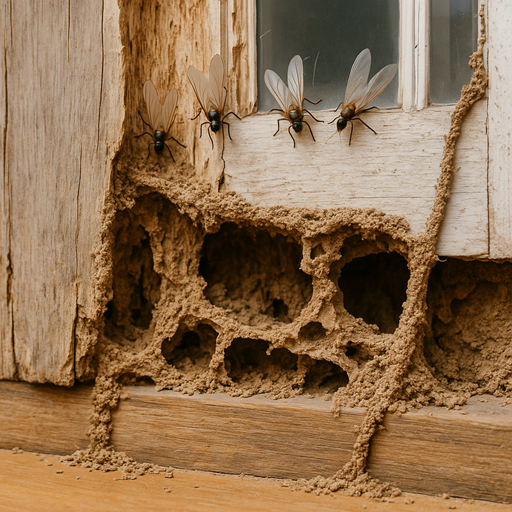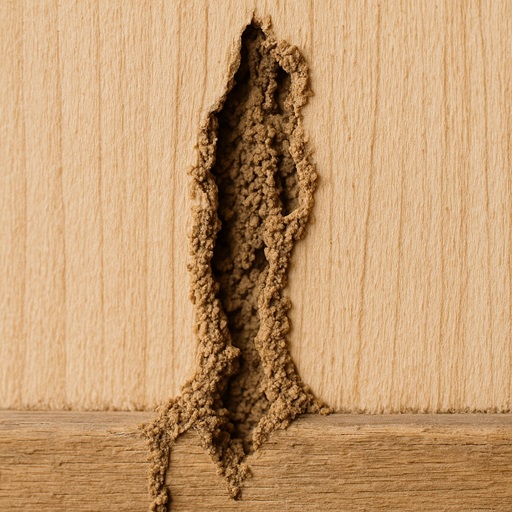
What Does a Termite Infestation Look Like? – Warning Signs Every Homeowner Should Know
Introduction
Termites are among the most destructive pests in the world, silently eating away at wood, drywall, and even paper-based materials in homes and buildings. Every year, termite infestations cause billions of dollars in structural damage globally. The worst part? Most homeowners don’t even know they have a problem until serious damage has already occurred.

This blog will walk you through how to spot the early signs of a termite infestation, what these signs look like, and what steps to take if you find any evidence. Early detection is key to preventing severe damage and expensive repairs.

1. Mud Tubes
One of the clearest signs of a subterranean termite infestation is the presence of mud tubes—narrow tunnels made of soil, wood particles, and termite saliva. These tubes protect termites from predators and dehydration as they travel between their nest and food sources.

You’ll usually find mud tubes:

-
Along foundation walls

-
On crawl space walls or concrete slabs
-
Behind baseboards
-
Around pipes or utility lines
They often appear as dry, dirt-colored veins climbing walls or structures. If you break one open and see live termites inside, that’s confirmation of an active infestation.
Image: Mud tubes on an indoor wall surface
2. Wood That Sounds Hollow
When termites feed, they consume wood from the inside out, often leaving just a thin surface layer intact. As a result, tapping on wood that has been damaged may produce a hollow or papery sound. In severe cases, it might even cave in with slight pressure.
Common places to check include:
-
Window sills
-
Door frames
-
Skirting boards and baseboards
-
Floorboards
This type of damage usually goes unnoticed until it becomes visibly extensive or causes structural issues.
Image: Cross-section of wood showing hollowed tunnels with visible termites
3. Swarmers (Winged Termites)
Swarmers are reproductive termites that leave the colony to mate and establish new nests. These winged termites are most visible during the warmer months and often appear in large numbers around light sources.
They typically:
-
Emerge from holes in wood or soil
-
Gather near windows or glass doors
-
Are mistaken for flying ants
Unlike ants, termite swarmers have straight antennae, uniform wings, and a thicker waist. Their presence indoors is a strong indication of an active colony nearby.
Image: Swarmers near a termite-damaged wooden window
4. Discarded Wings
After mating, termite swarmers shed their wings and return to the ground. If you notice piles of tiny, translucent, equal-sized wings near windowsills, vents, or doors, it's a sign that termites have entered your home and established a new colony.
You’ll often find these wings:
-
In corners of rooms
-
On window sills
-
Near baseboards
It's a subtle but powerful sign that requires immediate attention.
Image: Discarded termite wings collected around a window frame
5. Termite Droppings (Frass)
Drywood termites leave behind droppings known as frass. These appear as small, wood-colored pellets—often mistaken for sawdust or fine coffee grounds. Frass is typically found below infested wood or near small pinholes where termites have pushed it out.
Frass differs from general dust:
-
It has a fine, gritty texture
-
It appears in neat piles
-
It's usually brown or tan in color
This type of waste is a clear sign of drywood termite activity, especially in attic rafters or wooden furniture.
Image: Close-up of termite frass near wooden flooring and skirting
What To Do If You Spot These Signs
If you identify one or more of these signs, do not ignore them. Here’s what to do next:
-
Avoid disturbing the area too much, especially mud tubes or frass, as this can cause termites to move elsewhere.
-
Document the evidence by taking clear photos.
-
Contact a licensed pest control professional for an inspection and treatment plan.
The sooner you act, the less damage you’re likely to suffer.
Conclusion
Termite infestations are a serious threat to the safety and value of your property. Being able to identify the early warning signs—such as mud tubes, hollow wood, swarmers, discarded wings, and frass—can save you from costly repairs and stress. Whether you're in the United States, Australia, South Africa, or the UAE, these signs are universal and should never be ignored.
Stay vigilant. Inspect often. And when in doubt, call a professional.
Youtube Video
Invalid YouTube URL provided.
(0) Comments